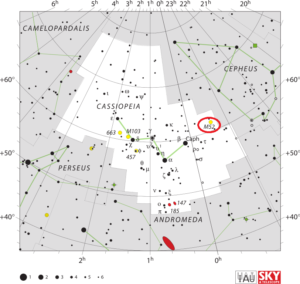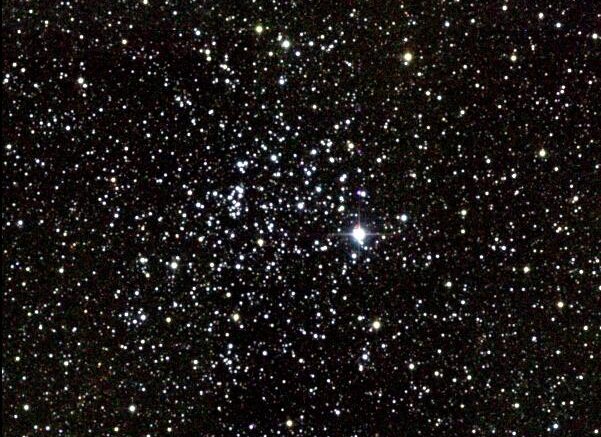Messier 52 or M52, also known as NGC 7654, is an open cluster of stars in the northern constellation of Cassiopeia. It was discovered by Charles Messier on September 7, 1774. M52 can be seen from Earth with binoculars. The brightness of the cluster is influenced by extinction, which is stronger in the southern half.
| Description | |
| Visible From Pacific Northwest | June To December |
| Best Time To Observe | September And October |
| Minimum Size Of Viewing Device | Binoculars |
| Object Type | Open Cluster |
| Designations | Messier 52, M52, NGC 7654, Collinder 455, OCl 260, C 2322+613, MWSC 3725 |
| Right Ascension | 23h 24.2m |
| Declination | +61°35′ |
| Constellation | Cassiopeia |
| Number Of Stars | More Than 100 |
| Apparent magnitude | +5.0 |
| Apparent dimensions | 13′ |
| Object Radius | 9.5 light years |
| Distance From Earth | 5,000 light years |
History
The cluster was discovered by Charles Messier, who catalogued it on September 7, 1774.
William Herschel observed the cluster on August 29, 1783 and wrote, “All resolved into innumerable small stars without any suspicion of nebulosity. 7 ft., 57. In the sweeper, 30, shows nebulosity, the stars being too obscure to be distinguished with its light tho’ considerable.”
John Herschel included the cluster in his catalogue as h 2238 in 1829 and later added it to the General Catalogue as GC 4957. He described it as a “cluster; large; rich; much compressed toward the middle; round; stars from 9th to 13th magnitude.”
Locating M52 In The Sky
Messier 52 is very easy to find as it lies near Cassiopeia‘s prominent W asterism, formed by the constellation’s brightest stars.
The cluster can be located by extending the line from Schedar, Alpha Cassiopeiae, to Caph, Beta Cassiopeiae to the northwest about the same distance as that between the two stars. The cluster lies only a degree south of the star 4 Cassiopeiae. The best time of year to observe it is during the autumn.

Viewing M52
Messier 52 can easily be seen with binoculars. In 10×50 binoculars, it appears as a hazy, nebulous patch of light. 4-inch telescopes reveal a dense, compressed star cluster populated by many faint stars, with a shape resembling that of the letter V.
More stars are visible in 6-inch and larger instruments. The cluster occupies an area just less than half of the size of the full Moon.
Photographing M52
Messier 52 is a common target for those who have DSLR and have the opportunity to image over a shorter period of time. There are several images that don’t require length imaging periods of time ranging from as little as 30 minutes to several hours.
https://www.cloudynights.com/topic/600309-messier-52-m52-ngc-7654-cassiopeia/
https://www.galactic-hunter.com/post/ngc-7635
Sources And Further Reading
Descriptions of all of Messier Objects can be found here.
https://freestarcharts.com/messier-23

Be the first to comment on "Messier 52"